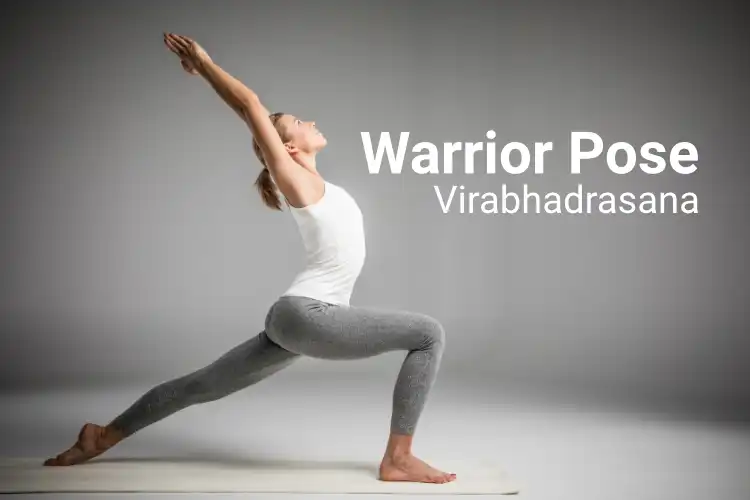Warrior Pose - An Insight to Better Posture with Benefits

Focus on the following warrior positions if you’re looking for an easy, invigorating series of standing yoga positions for your home practise. Even if you’re comfortable with these positions, there’s a lot of subtle nuances you can add to your alignment and get the most out of them while still strengthening your legs and spine and optimising forward and back bending.
If you do have space, start with a few stretching exercises to warm up. To tailor the length of the series, assess ahead of time and check the breaths you would like to keep in each posture. Begin with three breaths per posture if you’re not aware. Switch to a new posture on each breath for a more cardio-friendly routine.
Table of Content
Definition
Virabhadra is a Hindu god. Sana refers to a collection of positions identified after Virabhadra, a mighty warrior from Hindu mythology. The name comes from the Sanskrit words vira, which means “hero,” bhadra, which means “friend,” and asana, which means “pose.” The asana is also known as “warrior pose” in English.
What is the meaning of Virabhadrasana?
Virabhadra, a Shiva avatar, was incarnated to defeat Daksha, Brahma’s son. Daksha, as per the scripts, rejected Shiva’s relationship with his daughter Sati and exiled her from the family. Sati finally killed herself, according to the story depicted in the Hindu mythology. Shiva produced Virabhadra – a great warrior to exact vengeance in his grief. Thus, the name of this yoga pose derived from a great mythological warrior.
Beginning in a lunge posture, with the forward knee at a 90-degree angle and the back toes at a 45-degree angle, the Virabhadrasana position is performed. The feet should be parallel to the mat’s tip, and the shoulders should be level and straight.
The Virabhadrasana sequence of positions extends and strengthens the shoulders, arms, spine, thighs, knees, and back, in order to supply inner strength and control. They often necessitate equilibrium and versatility, as well as mental concentration while energizing the body.
Consult our online counselors to know about the daily benefits of doing yoga.
Here are a Few Examples of Variations:
Virabhadrasana 1: This posture is recognized as a fighter one and is a fundamental asana in other styles of yoga. It is part of Ashtanga yoga’s main sequence and a foundational asana in other fields of yoga. The palms of the hands are towards each other or interacting while the arms are lifted overhead.
Virabhadrasana 2: In English, this stance is recognized as warrior two, and it depicts a warrior spotting his opponent and planning for combat. At shoulder height, the arms are extended in opposite directions, and the focus is directed over the forward arm.
Virabhadrasana 3: This posture, also identified as warrior three or flying warrior in English, represents the soldier running rapidly to battle the enemy. The bodies are in the same place as in Virabhadrasana 1, however the back leg is lifted off the surface, and the arms, torso, and the leg are all parallel to the floor.
Baddha Virabhadrasana: This posture, also identified as a humble warrior in English, depicts bowing to the Lord. The palms of the hands are overlapping and interlaced behind the back. The shoulders hinge and the upper body folds over while the forward leg stays bent. The arms reach for the top of the head. If the crown of the head does not meet the surface, the attention must be directed downward.
Parsva/Viparita Virabhadrasana: This posture is similar to Virabhadrasana 2, but instead of resting on the back leg, the rear hand lies on the back leg while the front arm extends to the ceiling, forming a back arch. The attention remains fixed on the horizon. It’s known as the hand, opposite, or reversed warrior in English.
Want to save your favorite yoga poses on mobile? Download our App now.
Why should we do the Warrior Poses?
Virabhadrasana I (Warrior I)
Warrior I/Virabhadrasana should be practised on a regular basis. It improves hip stability while strengthening and toning the thighs, knees, and feet. The neck is twisted in this posture, while the elbows and side body loosen up, preparing you for backbends.
Warrior I, is a dynamic pose with a variety of common orientation clues to master even with all these different characteristics. Holding all of this in mind and being focused on the breath might feel like a balancing act. And besides, the Warrior Pose, titled after Virabhadra, the fierce warrior that is said to represent our inner strength to transcend pride and ignorance. Warrior poses put you to the test, but in the process, they give you determination, concentration, trust, and bravery.
In this position, the spine has a tendency to tip forward, creating a higher curve, or crunch, in the lower back. To address this, instead of tucking the tailbone under, try ‘lifting the pit of the belly’ to maintain strength in the lower back.
Virabhadrasana II (Warrior II)
Warrior II necessitates a high amount of fitness and balance, as well as hip and upper body flexibility. This tells us more about the equilibrium of sthira and sukha, or steadiness and ease, which is one of the main concepts of yoga asana practise. It also allows you to use your entire body in asanas and to know what we can’t see. Hold the back arm raised and the outside edge of the back foot grounded in this situation.
Warrior II is an excellent stance for learning to develop your body’s knee and ankle balance. Moreover, this asana provides a nice stretch to your shoulders, legs, ankles and groins. While practising Warrior II, monitor to see if the heel is pointed in the same way as the toes to support the knee and ankle joint.
Get a new perspective on wellness and experience a better life with our online therapist.







